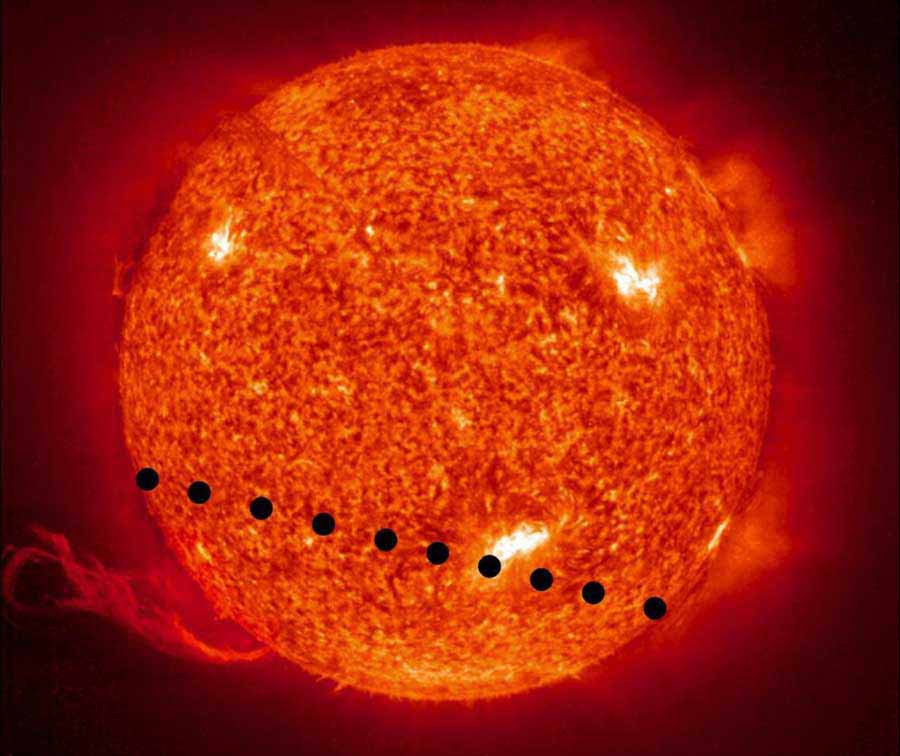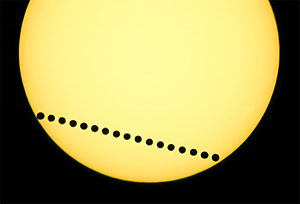
A time-lapse photo made using a high-powered government research telescope shows the path of Venus in front of the sun during a transit of Venus event. (NASA/ESA - click to enlarge)
From Staff Reports
MOOSE, WYO. — Unless you expect to live another 115 years, Tuesday will be your last chance to witness a transit of Venus. If you live in or are visiting Jackson Hole, a Grand Teton transit of Venus gathering offers a chance to see the event in the spectacular setting of a national park.
Grand Teton National Park and the Jackson Hole Astronomy Club will host a Grand Teton transit of Venus viewing event from 4 p.m. until sunset on Tuesday, June 5. Professional astronomer and park ranger naturalist Robert Hoyle will lead a discussion and demonstration for the twice-in-a-lifetime event at the Willow Flats Overlook north of Jackson Lake Junction.
Hoyle hosted a Grand Teton eclipse viewing event last month at Willow Flats that was attended by an estimated 500 people, with the Teton Range providing a dramatic backdrop for the annular solar eclipse. Hoyle has worked previously as an astronomer at the Morehead Planetarium and Science Center at the University of North Carolina in Chapel Hill.

A time sequenced composite image from June 2004 shows the transit of Venus against the sun. (photo by Fred Espenak)
Tuesday’s Grand Teton transit of Venus will be the last such event until 2117. A transit of Venus occurs when the planet moves in alignment with and directly between the earth and the sun, appearing as a small, black dot moving in front of the sun.
Because of the orbital geometry of the solar system, transits of Venus come in pairs separated by eight years, but then not taking place again for at least another 105 years. Tuesday’s is the second in the most recent pair, with the earlier transit of Venus happening in 2004.
Astronomers in the 1700s used the transit of Venus to determine the distance between the earth and sun, creating for the first time an accurate understanding of the true scale of the solar system.
Several telescopes equipped with special solar filters will be available for Tuesday’s Grand Teton transit of Venus gathering to allow spectators to safely view the event. Viewers will also have the chance to see some of the numerous sunspot groups currently visible.
Park officials and scientists widely caution skywatchers and photographers to avoid looking directly at an eclipse with the naked eye, no matter how dim it may appear. Even when mostly or totally obscured, viewing the sun at length — directly or with binoculars or other optics not designed for astronomical use — can be harmful, and may lead to permanent eye damage.
If you missed last month’s eclipse and can’t make it to Tuesday’s Grand Teton transit of venus event, there’s still another chance to view an astronomical wonder in Grand Teton National Park.
Long-term planners and sky-watchers around the Yellowstone National Park and Grand Teton area should mark their calendars for Aug. 21, 2017. On that date, a total solar eclipse will be visible in Grand Teton (but not in Yellowstone) at around 11:35 a.m. (That date is a Monday, so you might want to ask now for time off from work.)
To learn more about the science of eclipses, including viewing tips, visit the National Park Service website.
Reservations are not required for this event. For more information, contact the Colter Bay Visitor Center at 307-739-3594.
Contact Yellowstone Gate at info@yellowstonegate.com.
